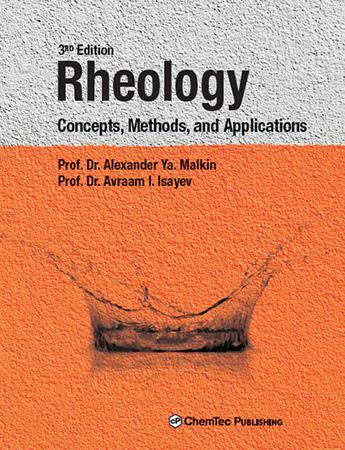The third edition of this excellent book brings many new additions, which include new methods and applications based on the most recently published literature. The most notable new sections discuss heterogeneity in flow, rheology of highly concentrated emulsions and suspensions, viscosity and viscoelastic behavior of nanocomposites, the behavior of supramolecular solutions, rheology of gels, deformation-induced anisotropy, conformation changes during flow, and molecular orientation.
The first four chapters of this book discuss various aspects of the theoretical rheology and, by examples of many studies, show how particular theory, model, or equation can be used in solving different problems. The main emphasis is on liquids but solid materials are discussed in one full chapter.
The goal of the rheological studies is not to measure some rheological variables but to generate relevant data and this requires experience and understanding of theory. The authors share their experiences of many years of experimental studies and teaching to show the use of rheology in studies of materials. This is one very strong aspect of this book which will help to avert costly confusions - common when data are generated under wrong conditions or data are wrongly used.
Methods of measurement and raw data treatment are included in one large chapter which constitutes over one-quarter of the book. Eight groups of methods are discussed here giving many choices for experimentation and guidance on where and how to use them properly.
The final chapter shows how to use rheological methods in different groups of products and methods of their manufacture. Usefulness of chemorheological (rheokinetical) measurements is also emphasized. This chapter continues with examples of purposeful applications in practical matters.
The authors are very meticulous in showing the historical sequence of developments which led to the present advancements in rheology. This aspect is of interest of specialists in rheology, professors, and their students because it shows in chronological order important events and teaches about their implications on further discoveries. References to various chapters and short summaries of achievements of many scientists give the essential historical background of contributors to rheology as a science and as the method of solving many practical problems.
Many people need this book, ranging from students to accomplished rheologists because it contains expert advice of two very famous and accomplished scientists and teachers who know discoveries first-hand because they may have taken part in some of them and they intent to pass their knowledge to the next generations. Previous editions of this book are used as a textbook in many universities worldwide.
This book is very useful in industrial applications but it is invaluable as a teaching tool in universities and colleges because it is consistent with programs of rheology courses. The practicality of this book will prepare students for typical tasks in industry.
Introduction. Rheology: Subject and Goals
1 Continuum Mechanics as a Foundation of Rheology
1.2 Deformations
1.3 Kinematics of deformations
1.4 Heterogeneity on flow
1.5 Summary − continuum mechanics in rheology
2 Viscoelasticity
2.1 Basic experiments
2.2 Relaxation and creep − spectral representation. Dynamic functions
2.3 Model interpretations
2.4 Superposition − The Boltzmann-Volterra Principle
2.5 Relationships among viscoelastic functions
2.6 Viscoelasticity and molecular models
2.7 Time-temperature superposition. Reduced (“master”) viscoelastic curves
2.8 Non-linear effects in viscoelasticity
3 Liquids
3.1 Newtonian and non-Newtonian liquids. Definitions
3.2 Non-Newtonian shear flow
3.3 Equations for viscosity and flow curves
3.4 Elasticity in shear flows
3.5 Structure rearrangements induced by shear flow
3.6 Limits of shear flow − instabilities
3.7 Extensional flow
3.8 Conclusions − real liquid is a complex liquid
4 Solids
4.1 Introduction and definitions
4.2 Linear elastic (Hookean) materials
4.3 Linear anisotropic solids
4.4 Large deformations in solids and non-linearity
4.5 Limits of elasticity
5 Rheometry Experimental Methods
5.1 Introduction − Classification of experimental methods
5.2 Capillary viscometry
5.3 Rotational rheometry
5.4 Plastometers
5.5 Method of falling sphere
5.6 Extension
5.7 Measurement of viscoelastic properties by dynamic (oscillation) methods
5.8 Physical methods
6 Applications of Rheology
6.1 Introduction
6.2 Rheological properties of real materials and their characterization
6.3 Rheokinetics (chemorheology) and rheokinetic liquids
6.4 Solution of dynamic problems
Notation
Solutions
Index




